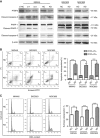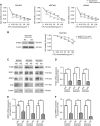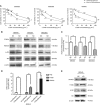Inhibition of polypyrimidine tract-binding protein 3 induces apoptosis and cell cycle arrest, and enhances the cytotoxicity of 5- fluorouracil in gastric cancer cells
- PMID: 28222070
- PMCID: PMC5379144
- DOI: 10.1038/bjc.2017.32
Inhibition of polypyrimidine tract-binding protein 3 induces apoptosis and cell cycle arrest, and enhances the cytotoxicity of 5- fluorouracil in gastric cancer cells
Abstract
Background: Human polypyrimidine tract binding protein 3 (PTBP3) was first discovered in 1999 and has been well characterised as a differentiation regulator. However, its role in human cancer has rarely been reported. Our previous study revealed increased PTBP3 protein level in gastric cancer tissues. Downregulation of PTBP3 suppressed the proliferation and differentiation of gastric cancer cells in vivo.
Methods: PTBP3 mRNA levels in human gastric cancer and adjuvant non-tumour tissues were detected. Apoptosis and 5-FU effect were determined in PTBP3-silenced gastric cancer cells. Underlying molecular mechanisms were investigated.
Results: MRNA expression of PTBP3 was upregulated in gastric cancer tissues, especially in those at an advanced stage. PTBP3 silencing led to apoptosis, under which modulation of PTB and thereby switch of Bcl-x pre-mRNA splicing pattern might be an important mechanism. Further research found that inhibition of PTBP3 expression enhanced the chemosensitivity of gastric cancer cells towards 5-FU treatment. This was mediated by reduced expression of histone deacetylase 6 (HDAC6), which further inhibited the phosphorylation of Akt and the expression of thymidylate synthase (TYMS), the critical determinant of 5-FU cytotoxicity.
Conclusions: PTBP3 might serve as a biomarker of gastric cancer or potential target for anti-cancer therapy.
Conflict of interest statement
The authors declare no conflict of interest.
Figures





References
-
- Baudis M, Prima V, Tung YH, Hunger SP (2006) ABCB1 over-expression and drug-efflux in acute lymphoblastic leukemia cell lines with t(17;19) and E2A-HLF expression. Pediatr Blood Cancer 47(6): 757–764. - PubMed
-
- Brazão TF, Demmers J, van IJcken W, Strouboulis J, Fornerod M, Romão L, Grosveld F (2012) A new function of ROD1 in nonsense-mediated mRNA decay. FEBS Lett 586(8): 1101–1110. - PubMed
MeSH terms
Substances
LinkOut - more resources
Full Text Sources
Other Literature Sources
Medical
Research Materials

